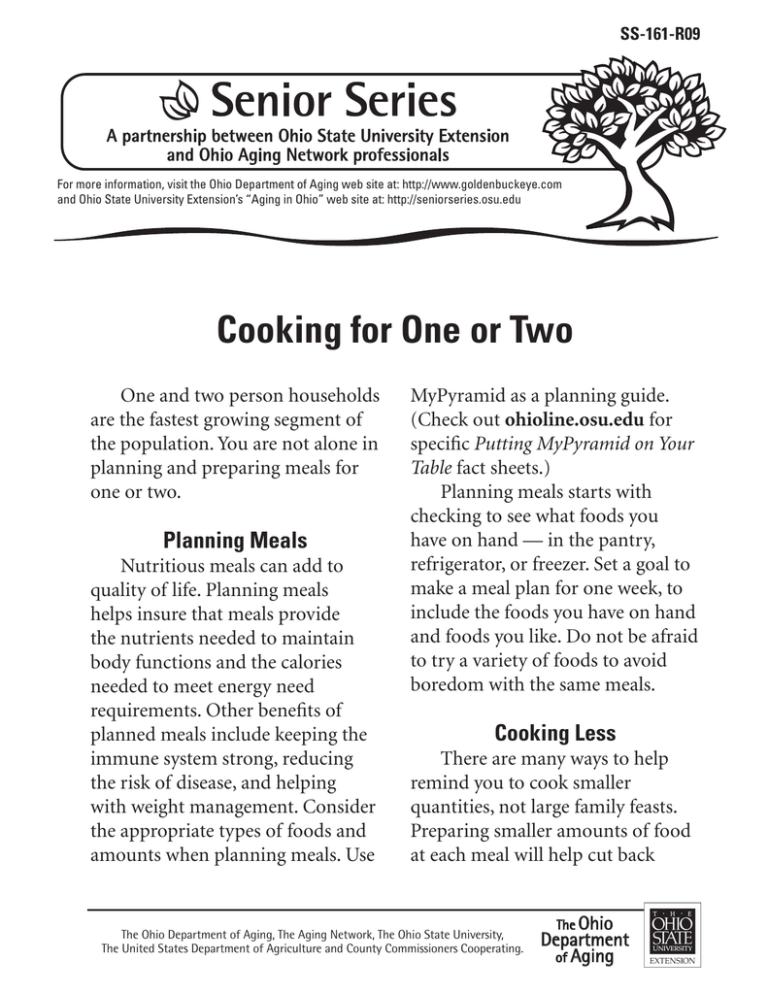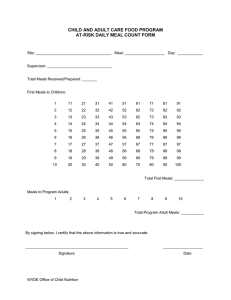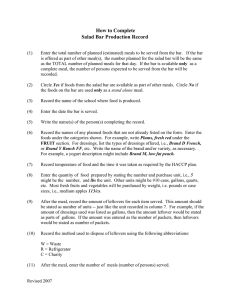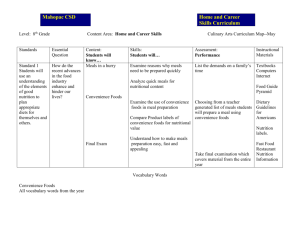Document 13278018
advertisement

SS-161-R09 For more information, visit the Ohio Department of Aging web site at: http://www.goldenbuckeye.com and Ohio State University Extension’s “Aging in Ohio” web site at: http://seniorseries.osu.edu Cooking for One or Two One and two person households are the fastest growing segment of the population. You are not alone in planning and preparing meals for one or two. Planning Meals Nutritious meals can add to quality of life. Planning meals helps insure that meals provide the nutrients needed to maintain body functions and the calories needed to meet energy need requirements. Other benefits of planned meals include keeping the immune system strong, reducing the risk of disease, and helping with weight management. Consider the appropriate types of foods and amounts when planning meals. Use MyPyramid as a planning guide. (Check out ohioline.osu.edu for specific Putting MyPyramid on Your Table fact sheets.) Planning meals starts with checking to see what foods you have on hand — in the pantry, refrigerator, or freezer. Set a goal to make a meal plan for one week, to include the foods you have on hand and foods you like. Do not be afraid to try a variety of foods to avoid boredom with the same meals. Cooking Less There are many ways to help remind you to cook smaller quantities, not large family feasts. Preparing smaller amounts of food at each meal will help cut back The Ohio Department of Aging, The Aging Network, The Ohio State University, The United States Department of Agriculture and County Commissioners Cooperating. The Ohio Department of Aging SS-161-R09—page 2 on food waste and unnecessary leftovers. Some foods are good prepared in large quantities and reheated while other recipes are more desirable when made in smaller quantities. Use the following ideas to help as you prepare smaller meals. Keep notes about what works and share these ideas with friends and neighbors. ■ Prepare foods or meals in smaller pans and baking dishes, checking for doneness five to ten minutes sooner than the original recipe states. ■ Purchase smaller quantities of foods and ingredients at the grocery store. Many foods are available in single serving packages. ■ Cut recipes in half to achieve a smaller number of servings. ■ Use cookbooks that have recipes designed for one or two people. When you have had a long day of activities, make use of prepared or processed foods. Many frozen meals require only a microwave oven for preparation. Keep in mind that many frozen meals are not nutritionally well balanced. Consider adding fresh fruits, vegetables, or a salad to these main entrees. Try to make the best use of time when preparing meals. While the oven is preheating, gather necessary utensils and ingredients for the meal. While the main dish or entree is baking, prepare side dishes or salads and set the table for the meal. Wash dishes as food is being prepared to minimize clean up time after the meal. Leftovers Using leftovers is a great way to decrease food waste and have food available for later meals. With careful planning, larger meals can be prepared early in the week and leftovers used for meals later in the week. For example, baked chicken breasts prepared for dinner on Monday can be used on Tuesday chopped up on a salad or in a chicken salad sandwich. Chili that is prepared for dinner can be used as a baked potato topping the next day for lunch. When storing leftovers, pay attention to food safety. It is important to date and store them properly. Place perishable leftovers in food-safe containers in the refrigerator or freezer. Label when the food needs to be used so that you do not have food spoilage SS-161-R09—page 3 issues. Check food storage charts for specific recommendations on length of storage. Remember to be aware of the expiration dates of all food items and leftovers—food does not last forever. Enjoy Your Meal Eating a meal can be very rewarding and is a wonderful time for socializing with others. Try to create an “atmosphere” for meals by decorating the dining room table. Occasionally use the fine china, get out the silver, and drink from crystal glasses. Hold weekly potlucks with friends and neighbors so that all of you can look forward to trying new foods and socializing with one another. Make eating meals an exciting part of the day, whether having a quiet dinner by yourself or getting together with your closest friends for a formal dinner. Make the most of every meal! Use MyPyramid as a meal planning guide. http://www.mypyramid.gov Original authors: Denise Reed, Human Nutrition Graduate Student and Dietetic Intern, and Alma M. Saddam, PhD, RD, Extension Specialist, Nutrition. Revised by: Linnette Mizer Goard, Extension Educator, Ohio State University Extension. Visit Ohio State University Extension’s web site “Ohioline” at: http://ohioline.osu.edu Ohio State University Extension embraces human diversity and is committed to ensuring that all research and related educational programs are available to clientele on a nondiscriminatory basis without regard to race, color, religion, sex, age, national origin, sexual orientation, gender identity or expression, disability, or veteran status. This statement is in accordance with United States Civil Rights Laws and the USDA. Keith L. Smith, Ph.D., Associate Vice President for Agricultural Administration and Director, Ohio State University Extension TDD No. 800-589-8292 (Ohio only) or 614-292-1868


